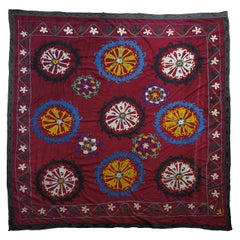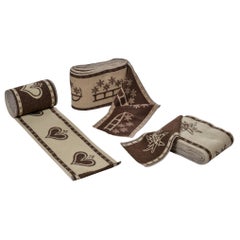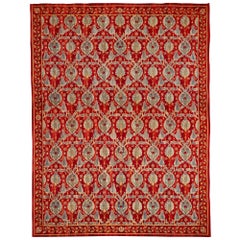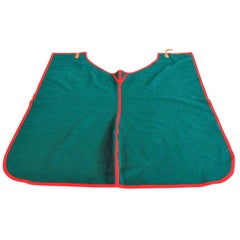20th Century Quilts and Blankets
1
66
to
20
66
299
66
66
66
8
3
2
2
1
1
1
1
2
20
66
183
9
22
30
2
2
3
1
4
8
1
1
63
34
17
5
4
38
12
12
10
8
3
1
1
1
1
Item Ships From: Europe
Period: 20th Century
Large Vintage Uzbek Suzani Needlework Textile Blanket or Tapestry
Located in Antwerp, BE
Large vintage Suzani Uzbek Samarkand textile, Suzani means needlework and these embroideries are some of the most characteristic forms of tex...
Category
Uzbek Mid-Century Modern 20th Century Quilts and Blankets
Materials
Silk, Cotton
Verner Panton Spectrum Curtains, Textile, Fabric for Mira-X, 1960s
By Mira-X, Verner Panton
Located in Schagen, NL
Vintage Verner Panton textile / curtains, manufactured in Denmark, circa 1960s. These pieces feature a symmetric template of multilayered spheres or circles (Spectrum) These layers v...
Category
Danish Space Age 20th Century Quilts and Blankets
Materials
Cotton
Wool Edges for Blankets or Curtains in the Mountain House
Located in Alessandria, Piemonte
Edges decorations for blankets or curtains, very beautiful for a Mountain House. They are in wool cloth from Switzerland.
Every roll is 6 meters, high 20 cm. and it is all straight,...
Category
Swiss Country 20th Century Quilts and Blankets
Materials
Wool
Arts & Crafts Floral Red Art Needlework Panel
Located in London, GB
This exquisite textile was created in England in the early 20th century, when the Arts & Crafts style was in fashion in the decorative arts. The movement championed traditional methods of working by hand to create beautiful objects which were then decorated with motifs and patterns inspired by nature. Arts & Crafts practitioners created a variety of objects, including metalwork, jewelry, wallpaper, textiles and furniture. Because of the influence of the Arts & Crafts movement, art needlework panels...
Category
English Arts and Crafts 20th Century Quilts and Blankets
Materials
Fabric, Textile
Pair of Karel Appel Curtains, 1963, Documented at Stedelijk Musem
By Karel Appel
Located in bergen op zoom, NL
Super rare and impressive pair of large cotton ''gordijnstof' curtains, designed in 1963 by world renowned Dutch painter and sculptor Karel Appel (1921-2006) for the textile company Hermann Hartman & Co of Amsterdam.
This extremely rare, original repeat print textile is documented in the Stedelijk museum's textile collection under object nubmer KNA 1998, please see image 2.
Each curtain measures 56.7" X 83.85" (144cm X 213cm).
'Gordijnstof' translates as "curtain fabric" confirming that this textile was originally designed by Appel specifically for use as curtains however being of such an impressive dimension these examples could equally be used as wall hangings ,as photographed, or mounted on both sides of a screen or mounted and framed as an art work in its own right , a practice which is becoming increasingly commonplace as high end textile designs by important artists are becoming increasingly valued , appreciated and sought after in the marketplace.
Appel's paintings and sculptures can be found in the collections of some of the world's most prominent museums including the Museum of Modern art in New York and Tate Modern ,London.
Each curtain is of a very impressive scale with each measuring
56.7 " (144 cm) X 83.85" (213cm).
The curtains are signed on the banding KUNSTENAAR DESSIN ONTWERP Karel Appel, HARTMAN PRINT, AMSTERDAM. Another of Appel's designs for Hermann Hartman,Amsterdam can be found in the collection of the national textile museum in Holland. Please see image 9.
Even a small sample of this 1963 textile in good condition would be hard to find today but to find two large scale Appel curtains intact and in beautiful unfaded condition with no staining or fraying must be next to unique today. This is a very rare find and certainly a unique opportunity.
Image 10 shows Karel Appel in his atelier in New York in 1966.
Provenance:
These curtains come from the private collection of a retired Professor from Oxford,UK.
Biography:
Karel Appel was an Expressionist Dutch painter. He was a member of the famous Cobra, the European group of the late 1940s to early 1950s, which promoted spontaneous expressionism and abstract features in painting. Appel's paintings incorporate applications of vibrant, violent colors often possessing a primal, childlike quality or a schizophrenic innocence. Later in life, Appel turned to creating figurative sculptures. Examples of his work can be seen in the Museum of Modern Art, New York City, Boymans-Van Beuningen Museum, Rotterdam, and other collections. Expressionist painter Karel Appel made a name for himself in the world of painting by creating a majestic collection of highly distinguishable work for which he became internationally renowned. From the start, art curators could not ignore Appel's work, which has been exhibited at major museums around the world, including New York's Museum of Modern Art, the Manhattan-based Guggenheim Museum, the Museum of Fine Arts in Boston and the Tate Gallery in London. Though Appel is widely recognized as one of the best-known Dutch Expressionist painters of all time, he was also a passionate printmaker, sculptor, and ceramicist.
Karel Appel’s childhood and early life
Christiaan Karel Appel was born on April 25, 1921, in his parents’ house at 7 Dapperstraat, Amsterdam. His father, Jan Appel, owned a barbershop. His mother, born Johanna Chevalier, was a descendant of French Huguenots. Karel Appel had three brothers. He studied art from 1940 to 1943 at the Rejksakademie van Beeldende Kunsten, the Royal Academy of Fine Arts during the German occupation and befriended young painter Corneille and, some years later, Constant. His parents opposed his choice to become an artist, leading him to leave home. This was also necessary to hide himself from the German police so that he would not be picked up and sent to Germany to work in the weapon industry. Appel produced his first real painting on canvas, which was a still life of a fruit basket at the age of fourteen. On his fifteenth birthday, his wealthy uncle Karel Chevalier gave him a paint set and an easel and some lessons on painting.
Career.
In 1946, his first solo show was held in Groningen, Netherlands. He also participated in the Jonge Schilders exhibition at the Stedelijk Museum of Amsterdam nd created a buzz in the art world, as it generated a huge scandal and many objections in the press and public. About this time, Appel was influenced first by Pablo Picasso and Henri Matisse, then by the French brute-art artist Jean Dubuffet. In 1947, he started sculpting with various used materials and painted them in bright colors such as white, red, yellow, blue and black. Karel Appel became the member of Nederlandse Experimentele Group in Holland along with the young Dutch painters Anton Rooskens...
Category
Dutch Mid-Century Modern Vintage 20th Century Quilts and Blankets
Materials
Cotton
Italian Handcrafted Green Blanket Horse Throw Wool Leather Selleria Pariani 1980
Located in Arosio, IT
A piece of Italian history in your home:
Adolfo Pariani founded his business in 1903. They were the first Saddlery in the whole world that used a saddle tree that was flexible which meant it was elastic and shock-absorbing.
Since then Selleria Pariani supplied personalities of the 20th century, such as George Patton...
Category
Italian Mid-Century Modern Vintage 20th Century Quilts and Blankets
Materials
Wool, Leather
1950s Evening Frock/Gown
Located in Brecht, BE
A wonderful evening dress, velvet purple, embroidered with beads, size 40 it says,
but it is a European size 36, made and labelled by Maison Lehman, Basel, Switzerland.
Category
Swiss 20th Century Quilts and Blankets
Materials
Fabric, Velvet
Vintage Cotton “Cake Stand Baskets" Quilt in Blue and White, USA, 1920s
Located in Copenhagen K, DK
USA, 1920's
“Cake Stand Baskets” antique quilt.
The triangles make for a more complex design than many Basket quilts are.
This example is very well pieced and quilted. The white off...
Category
American Vintage 20th Century Quilts and Blankets
Materials
Cotton
Recently Viewed
View AllMore Ways To Browse
Red And White Vintage Quilts
Queen Sized Quilts
Vintage Blue Wool Blanket
Signature Quilt
White Coverlet
Vintage Hand Quilted Quilts
Floral Tablecloth
Antique Indian Beds
Embroidered Bedspread
Retro Quilt Set
Vintage Camp Blankets Blankets
Vintage Camp Blanket
Vintage Camping Blanket
Vintage Camping Blankets
Quilt India Vintage
Quilt Blocks Vintage
Vintage Indian Blankets
Retro Patchwork Quilt





